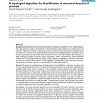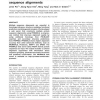115 search results - page 4 / 23 » Regression analysis of multiple protein structures |
BMCBI
2007
13 years 7 months ago
2007
Background: Identification of the structural domains of proteins is important for our understanding of the organizational principles and mechanisms of protein folding, and for ins...
NAR
2007
13 years 7 months ago
2007
Multiple sequence alignments are essential in homology inference, structure modeling, functional prediction and phylogenetic analysis. We developed a web server that constructs mu...
BMCBI
2006
13 years 7 months ago
2006
Background: Since the publication of the first draft of the human genome in 2000, bioinformatic data have been accumulating at an overwhelming pace. Currently, more than 3 million...
HPDC
2010
IEEE
13 years 8 months ago
2010
IEEE
A common task in biological research is to predict function for proteins by comparing sequences between proteins of known and unknown function. This is often done using pair-wise ...
BMCBI
2008
13 years 7 months ago
2008
Background: A multiple sequence alignment (MSA) generated for a protein can be used to characterise residues by means of a statistical analysis of single columns. In addition to t...


